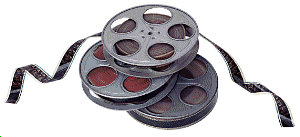Framing
is an important part of visual film study. It is one of the key signifiers of film as an
art form, that composition applies to film as much as it does to other visual
media.
The frame and camera movement are dependant on each other. There are classifications, as
seen in Types of shot, and Types of movement.
Angle and direction
The angle of the frame specifies certain relationships between viewer and situation. The
camera looking up to a person may imply a submissive relationship, as with a child.
Consider this in Citizen Kane, and contrast to an 'inferno' thriller, looking
straight down from the roof of a skyscraper.
Point of view
Optical
What you are seeing now is through your own optical point of view - directly of a person's
eyes. An example is a horror film, where the stalker is shown by its optical point of
view. You may never see the stalker's appearance, but you understand where the stalker is
and what it is thinking by the use of its optical point of view.
Point of View shots, thus, can assume the identity of someone, even if it cannot be
attributed to a diegetic character.
This can open up new levels of discourse.
A major example is Klute (Alan Pakula, USA, 1971). For much of the
film, Bree Daniels (Jane Fonda) is the object of the camera's gaze. Does this mean
that she is the controlling presence of the film? Is the point of view a dominant male
entity?
Klute was used by Laura Mulvey in her work on spectatorship, Visual Pleasure and
Narrative Cinema. A full definition of this work can be found here.
Associated
Imagine a camera on your shoulder, seeing everything you do. It not only sees what you
see, but also includes a portion of your body, giving it a degree of intimacy. An example
is a cowboy shootout. An associated point of view may be at the side of a cowboy - you can
see the body and any related bodily movement, such as reaching for a gun.
Point-of-view is described in terms of narrative by Edward Brannigan:
The specific thrust of the argument is to locate the spectator as the fundamental
organising agency, the subject who makes use of the relations, the cues and shifts along
the various levels of narrative form, to make sense of the fictional world.
Point-of-view, in this treatment, links the discourse, or the textual mechanisms of shot/reverse shot, eyeline matches, camera movements, etc., to the
story-world - the world of events, characters, fictional space and time.
Robert Stam, Robert Burgoyne, Sandy Flitterman-Lewis. New
Vocabularies in Film Semiotics. London: Routledge, 1992.
The point-of-view system developed in tandem with technological innovation in editing:
Filmmakers had discovered that continuity could be held while varying the shots, as
long as there was careful attention to screen direction. The added implication of a change
of angle is that it is no longer necessarily the point of view of one of the characters;
it may be a privileged point of view, that of the "narrator" or the film's spectators.
Eileen Bowser. The Transformation of Cinema. Berkeley: University
of California Press, 1990. p.261.
Widescreen
Why are films shot in widescreen?
Our eyes perceive in widescreen. Take a look at the world around you - you can see much
more looking horizontally than vertically. Thus, widescreen is the method which is the
easiest for our brain to perceive. The common ratios of widescreen are 1:2.2 (2.2
centimetres of horizonal for every 1 of vertical), used in 70mm film.
The numeric definition of horizontal to vertical is the aspect ratio.
Open and Closed Form
The Closed Shot is where we are content with what is going on completely inside
the frame - we develop a 'nonawareness' that we are watching a film.
The Open Shot is where we are (subliminally or otherwise) aware of what is
happening in the area outside of the frame. Imagine a scene where two people are talking,
but only one is in the frame.
On a wider subject, Umberto Eco discusses notions of open and closed in his book The
Role of the Reader.
Source: www.imperica.com

